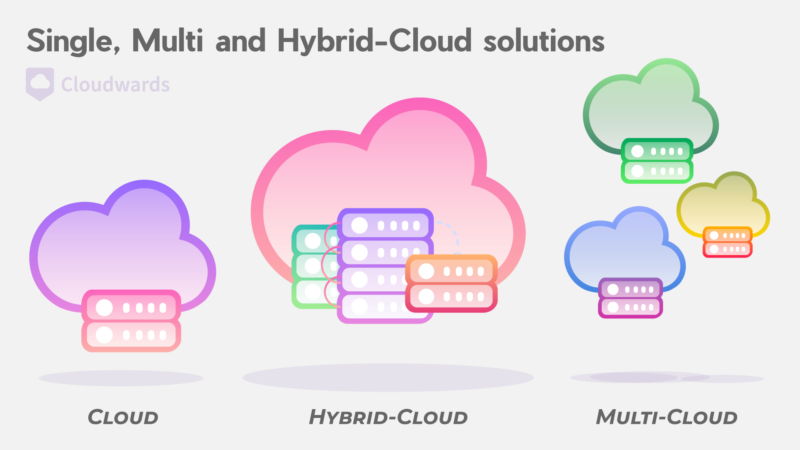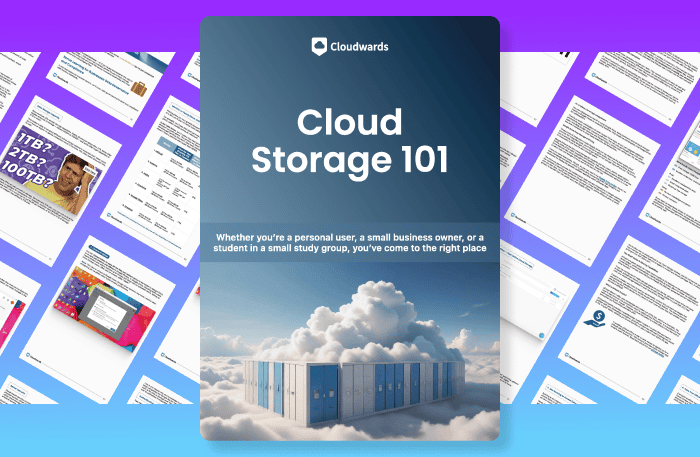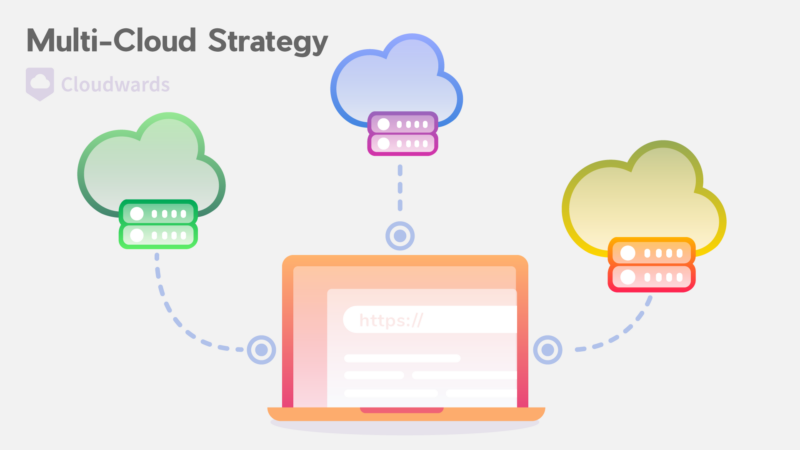Single-Cloud vs Multi-Cloud: Which Business Strategy Is Best in 2025?
Adopting a cloud strategy is about more than just choosing a cloud storage service to hold data. Businesses can opt for a single cloud provider, including storage, hosting and application deployment. Alternatively, a company can diversify its cloud services. To help you decide, we compare multi-cloud vs single-cloud strategies.
Key Takeaways: Single-Cloud vs Multi-Cloud Strategies
- When choosing cloud services, a business can opt for a single-cloud strategy or a multi-cloud strategy.
- Single-cloud benefits can include lower costs, ease of use and simplified services. Cons include limited scaling options and enhanced risk.
- The benefits of a multi-cloud strategy include scalability, risk mitigation and data recovery. Cons include more complex IT management and potential security or compliance issues.
Businesses in the market for a cloud service have to choose between a single-cloud and a multi-cloud solution. Both strategies have pros and cons, and choosing either one cloud service or more isn’t easy. We compare and contrast multi-cloud vs single-cloud in the following sections to help you decide on the best fit for your business.
With a single-cloud strategy, businesses can better plan their monthly budgets and maintain a streamlined IT process by working with one provider. Multi-cloud adopters, using services such as AWS or Azure, can better scale their operations and diversify their risk. We go over these considerations and more in the following sections.
Defining Multi-Cloud vs Single-Cloud Strategies
The difference between a multi-cloud and a single-cloud strategy boils down to whether a business relies on a single cloud service or a variety of cloud services to cover its needs. Cloud services include Software as a Service (SaaS), Infrastructure as a Service (IaaS), Platform as a Service (PaaS) and cloud computing.

What Is a Single-Cloud Strategy?
A single-cloud strategy is when a business uses one provider to meet its cloud service needs. For example, if a company chooses one of the best cloud storage solutions.
10,000+ Trust Our Free Cloud Storage Tips. Join Today!

- Demystify cloud storage terminology and key concepts in plain language
- Discover easy-to-implement techniques to securely backup and sync your data across devices
- Learn money-saving strategies to optimize your cloud storage costs and usage
All external cloud services are centralized with one provider. Sometimes, on-premise IT solutions like servers provide local cloud services.
Pros of Single-Cloud Strategy:
- Simplicity: Businesses deal with only one service provider and can quickly become familiar with its offerings.
- Budget-friendly: It is easier to budget costs when the negotiated amount is consistent with a single service provider.
- Streamlined IT: IT managers don’t have to juggle multiple infrastructures and services, making it easier to streamline systems and resources.
- Seamless integration: Working in one ecosystem helps to integrate among different services or applications, improving productivity.
Cons of Single-Cloud Strategy:
- Less flexibility: Businesses don’t have the option to switch between services if a certain offering doesn’t meet their needs or requirements.
- Vendor lock-in: Staying with one vendor for an extended period makes it hard to switch providers should the need arise.
- Scaling: Businesses run the risk of outgrowing a cloud service provider if it can’t scale with increased needs or demands.
- Enhanced risk: If a network outage, data breach or other catastrophic event occurs, businesses could be cut off from their data, access or connectivity.
What Is a Multi-Cloud Strategy?
A multi-cloud strategy uses more than one cloud service to meet a business’s needs or requirements; for example, using multiple business cloud storage services for different functions. Companies can compare and negotiate the best prices to leverage IT services and solutions.

Pros of Multi-Cloud Strategy:
- Flexibility: Businesses can choose the cloud solution offering the best services or products, depending on the use case.
- Data recovery: In the event of a disaster with one cloud service, a business that spreads its data among multiple cloud providers minimizes any potential impact.
- Cost-effectiveness: Businesses can negotiate for the best contract, terms or service-level agreement that fits within their budget constraints.
- Scalability: Multi-cloud environments let companies scale their operations as their business grows and IT needs change.
- Risk avoidance: By diversifying services and infrastructure across multiple cloud providers, companies mitigate the risk of service impacts.
Cons of Multi-Cloud Strategy:
- Data management: Depending on capacity and personnel, businesses have to allocate resources to manage multiple platforms and services.
- Onboarding and training: Training staff on more than one platform can be time-consuming.
- Overly complex: IT staff could face data compatibility, customization or application interaction challenges when dealing with multiple cloud platforms.
- Security/compliance issues: Meeting internal security and compliance policies can be challenging when using multiple cloud services, as each platform has different policies and practices.
Comparing Multi-Cloud and Single-Cloud on Key Factors
Businesses have many factors to consider when choosing between a single cloud provider and a multi-cloud strategy. However, a few important elements rise to the top.
1. Cost Considerations: Multiple Cloud Providers vs a Single Cloud Provider
There’s an argument on both sides. A single-cloud approach often makes it easier to budget monthly or annual costs, as only one bill comes from one vendor. However, even bundling services may not be as cost-effective as a multi-cloud strategy.
However, procuring services from multiple providers generally costs more. Though there is typically a higher overall cost for multiple cloud providers compared to a single-cloud solution, companies can find the right service for the best price and negotiate better contracts.
2. Flexibility and Scalability Comparison
One of the main drawbacks of a single-cloud solution is the potential for a business to outgrow the provider’s cloud capabilities. Moving to another cloud service can be a significant and costly challenge.
Businesses using multiple clouds are better equipped to handle growth and scale their cloud services to meet increased demands.
3. Data Security & Compliance
Cloud providers have different privacy policies, security protocols and compliance adherence. Some or all of these elements may be at odds with a business’s internal data security and compliance requirements.
With a single-cloud solution, the data security and compliance measures may not align perfectly between the business and the provider. However, finding a provider that checks as many boxes as possible can be easier than trying to ensure alignment across multiple cloud providers.
4. Ease of Management and Operations
With a single cloud provider, IT managers and administrators don’t have to stress over fixing issues with multiple infrastructures. Additionally, a single-cloud solution may require fewer employees to keep things running smoothly.
Management and operations with a multi-cloud approach are inherently more complex, with IT managers and administrators dealing with acceptance and compatibility issues and juggling multiple infrastructures.
When Should You Use a Single-Cloud vs a Multi-Cloud Environment?
Generally, single-cloud is better for smaller and simpler businesses, while multi-cloud benefits international companies that need greater flexibility and scalability. This section will examine when companies should consider either solution.
Use Cases Better Suited for Single-Cloud
Businesses that opt for a single cloud provider may operate on a tight budget or have technical and business requirements that are not overly demanding.
Who would benefit from a single-cloud solution:
- Start-ups
- Small businesses
- Freelancers
Scenarios Where Multi-Cloud Excels
Businesses that want to diversify their cloud providers would benefit from using multiple clouds.
Who would benefit from a multi-cloud strategy:
- Large enterprises and organizations
- Multinational corporations
- Companies with a global customer and client base
Hybrid Cloud Strategies: The Best of Both Worlds
Businesses can also choose to use a hybrid cloud strategy, especially if there is some uncertainty about deciding between a single-cloud and a multi-cloud strategy. A hybrid cloud strategy employs a public cloud for some infrastructure needs or other cloud deployment models, while also keeping on-premise IT hardware or software.
How to Choose the Right Cloud Strategy
Choosing between a single- and a multi-cloud strategy can be a challenging but important decision. We’ve listed several considerations to help businesses arrive at the best option.
- Analyze Current and Future Business Needs:
Even if a business needs only a single cloud provider today, that doesn’t mean it won’t deal with changes like customer growth, business expansion or increased cloud capacity needs in the future.
If such growth or change is far off in the future or if projections show that a single cloud provider will be enough for the next several years, then a business might not need to go the multi-cloud route. However, if growth or increased cloud needs could happen sooner rather than later, a company might outgrow a single cloud provider more quickly than projected. - Evaluating In-House Skills and Resources:
The personnel and the training capabilities that a company has on hand is a significant factor to consider. If the staff cannot manage more than one provider or it puts a strain on other departments or resources, a multi-cloud strategy may not be the best approach. - Understanding the Pros and Cons of Your Situation:
Business managers and leadership are often positioned optimally to decide which strategy is best for the company. Considerations include the business’s needs and requirements, staffing constraints and existing infrastructure. - Developing a Cloud Strategy Roadmap:
Most businesses have a growth strategy that can be aligned with a cloud strategy. Even if a company goes with a single-cloud solution, that doesn’t mean that it is locked in with that provider. A long-term cloud strategy roadmap can anticipate changes and allow the business to adjust to growth and changes in the future.
Final Thoughts
Choosing between a single-cloud and a multi-cloud strategy is essential for companies of any size to get right. There are many factors to consider, including: cost, compatibility, data security and scalability. For smaller-sized businesses, a single-cloud solution may be all that’s needed. A multi-cloud solution is often the best option for larger companies or enterprise-sized operations.
Which strategy does your company employ? How did you make that decision? Which provider or providers do you use for your cloud services? Let us know in the comments section below. Thanks for reading our article.
FAQ: Single-Cloud vs Multi-Cloud
A single-cloud strategy means that a business is limited to one cloud service provider. A multi-cloud strategy means that a business employs more than one cloud service provider to meet its business needs and requirements.
The pros of a single cloud are typically its budget-friendly costs and ease of use. Pros for multi-cloud services include service flexibility and scalability. Single-cloud cons include being limited to only one vendor and scalability concerns. Multi-cloud cons include concerns with integration and inconsistent security and privacy.
The main advantage of a multi-cloud strategy is the flexibility it provides. Organizations that use a multi-cloud approach can choose the vendors and services that meet their business needs and requirements.


